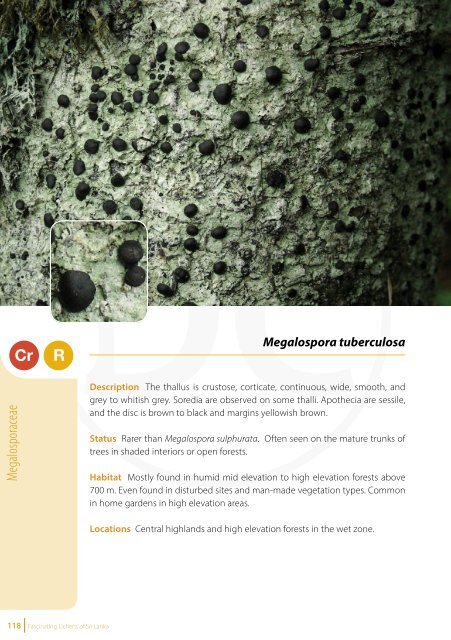Create successful ePaper yourself
Turn your PDF publications into a flip-book with our unique Google optimized e-Paper software.
Parmotrema<br />
Ruffle lichens, Scatter-rug lichens<br />
Lecanorales Parmeliaceae<br />
c.350<br />
Parmotrema is a genus <strong>of</strong> large, pale grey or grey -green to yellow green, foliose<br />
lichens with broadly rounded lobes. Most species are loosely attached, typically<br />
marginally ciliate, and have a black, rhizinate undersurface with a naked, marginal<br />
zone. This genus is best developed in tropical region. Species <strong>of</strong> this genus are<br />
large, conspicuous foliose lichens.<br />
More than 20 species are known from <strong>Sri</strong> <strong>Lanka</strong> up to date, the most common <strong>of</strong><br />
which tend to be Pantropical species. Recent research by Weerakoon and Aptroot<br />
(2014) document many new records <strong>of</strong> this genus for <strong>Sri</strong> <strong>Lanka</strong>, including five<br />
species that are new records for the Indian subcontinent. The <strong>Sri</strong> <strong>Lanka</strong>n species<br />
<strong>of</strong> Parmotrema occur on tree trunks, twigs, canopy branches, and on rocks <strong>of</strong> rain<br />
forests, sub-montane, montane and dry deciduous forests throughout moister<br />
areas.<br />
Megalosporaceae<br />
Cr<br />
R<br />
Megalospora tuberculosa<br />
Description The thallus is crustose, corticate, continuous, wide, smooth, and<br />
grey to whitish grey. Soredia are observed on some thalli. Apothecia are sessile,<br />
and the disc is brown to black and margins yellowish brown.<br />
Status Rarer than Megalospora sulphurata. Often seen on the mature trunks <strong>of</strong><br />
trees in shaded interiors or open forests.<br />
Habitat Mostly found in humid mid elevation to high elevation forests above<br />
700 m. Even found in disturbed sites and man-made vegetation types. Common<br />
in home gardens in high elevation areas.<br />
Species <strong>of</strong> Parmotrema are mainly separated by characteristics such as the<br />
presence or absence <strong>of</strong> asexual propagules, and by medullary chemistry. Most<br />
species known from <strong>Sri</strong> <strong>Lanka</strong> are overlooked and need taxonomic revision.<br />
Studies are also needed to collect and identify the total diversity <strong>of</strong> this genus<br />
in <strong>Sri</strong> <strong>Lanka</strong>, as it can be assumed that many more species remain undiscovered<br />
in other habitats.<br />
Apothecia laminal, lecanorine, generally pedicellate (stalked), disc brown;<br />
Asci: 8-spored; Spores: colourless, simple, ellipsoid, thick walled.<br />
Chemistry varies from species to species. Testing with K, PD and C is important<br />
for identification <strong>of</strong> species.<br />
Parmeliaceae<br />
Locations Central highlands and high elevation forests in the wet zone.<br />
118 <strong>Fascinating</strong> <strong>Lichens</strong> <strong>of</strong> <strong>Sri</strong> <strong>Lanka</strong><br />
<strong>Fascinating</strong> <strong>Lichens</strong> <strong>of</strong> <strong>Sri</strong> <strong>Lanka</strong> 119















